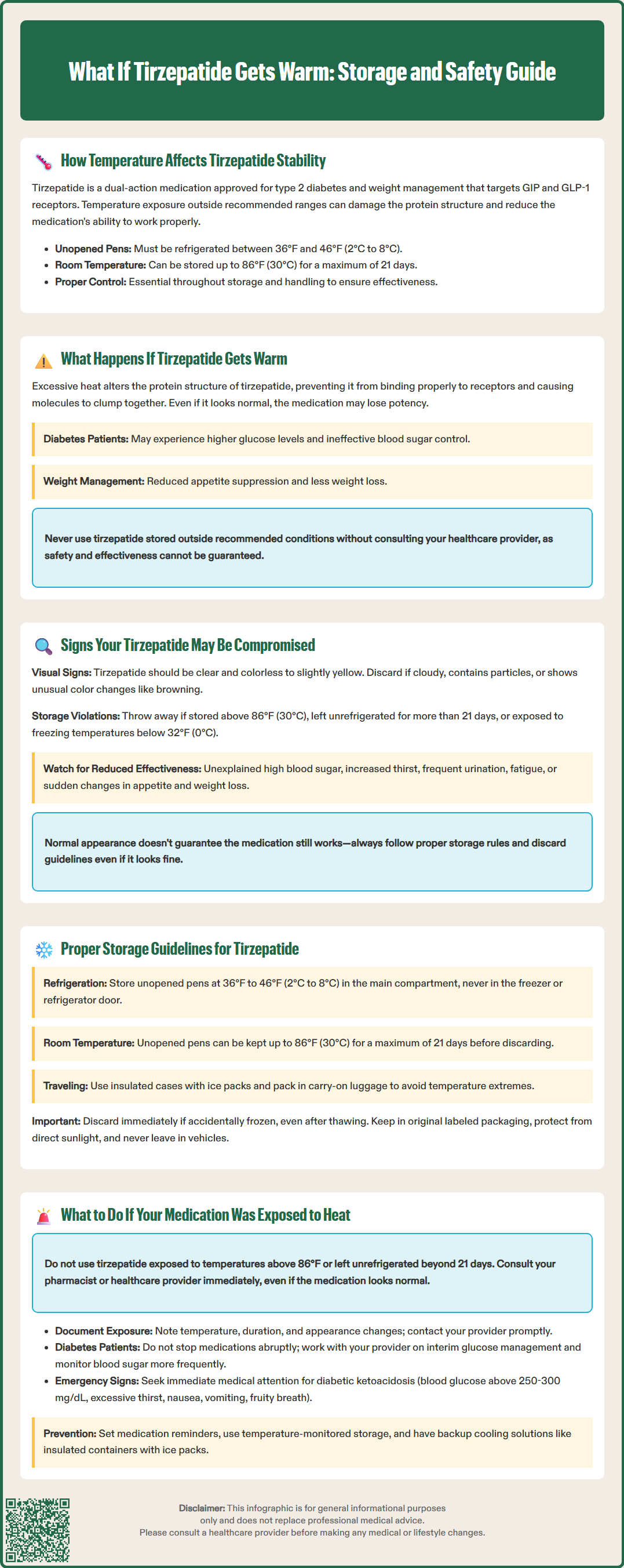LOSE WEIGHT WITH MEDICAL SUPPORT — BUILT FOR MEN
- Your personalised programme is built around medical care, not willpower.
- No generic diets. No guesswork.
- Just science-backed results and expert support.
Find out if you’re eligible

Tirzepatide, a dual GIP and GLP-1 receptor agonist marketed as Mounjaro and Zepbound, requires careful temperature management to maintain its effectiveness. As a peptide-based biologic medication, tirzepatide's molecular structure is sensitive to heat exposure, which can compromise its therapeutic potency. Understanding what happens when tirzepatide gets warm and how to properly store this medication is essential for patients managing type 2 diabetes or pursuing chronic weight management. This guide explains temperature stability requirements, signs of compromised medication, and steps to take if heat exposure occurs.
Quick Answer: When tirzepatide gets warm above 86°F (30°C) or stays unrefrigerated beyond 21 days, the medication may lose potency and should not be used without consulting a healthcare provider.
Tirzepatide is a glucose-dependent insulinotropic polypeptide (GIP) and glucagon-like peptide-1 (GLP-1) receptor agonist approved for type 2 diabetes management and chronic weight management. As a peptide-based biologic medication, tirzepatide's molecular structure is sensitive to environmental conditions, particularly temperature fluctuations.
The FDA-approved prescribing information for tirzepatide (marketed as Mounjaro for diabetes and Zepbound for weight management) specifies temperature requirements to maintain pharmaceutical stability and therapeutic efficacy. Unopened pens should be refrigerated between 36°F and 46°F (2°C to 8°C). According to FDA labeling, tirzepatide may also be stored at temperatures not exceeding 86°F (30°C) for up to 21 days.
When tirzepatide is exposed to temperatures outside the recommended ranges, the medication's stability may be compromised. The protein structure can undergo changes that affect its ability to bind effectively to GIP and GLP-1 receptors. This temperature sensitivity is characteristic of peptide therapeutics and necessitates careful handling throughout the medication's lifecycle. Understanding these stability principles helps patients and healthcare providers maintain medication integrity and ensure optimal therapeutic outcomes.
When tirzepatide is exposed to temperatures above the recommended storage range, degradation processes can compromise the medication's effectiveness. The primary concern is loss of potency, meaning the medication may deliver a reduced therapeutic effect even if it appears visually unchanged. According to FDA labeling, tirzepatide can be stored at temperatures not exceeding 86°F (30°C) for up to 21 days, but exposure to higher temperatures or for longer periods may affect the medication's stability.
The biochemical changes occurring during excessive heat exposure can include protein structure alterations that may prevent tirzepatide from properly binding to its target receptors in various tissues. Additionally, higher temperatures can promote aggregation, where individual tirzepatide molecules may clump together, potentially reducing pharmacological effects.
Clinically, using tirzepatide that has been improperly stored may result in inadequate glycemic control for patients with type 2 diabetes, with higher-than-expected blood glucose levels. For patients using tirzepatide for weight management, compromised medication may lead to reduced appetite suppression and suboptimal weight loss outcomes. If storage conditions have not been met, the safety and efficacy of the medication cannot be assured. Patients should never use medication that has been stored outside recommended conditions without consulting their healthcare provider, as individual circumstances vary and alternative treatment may be necessary to maintain disease control.

Identifying potentially compromised tirzepatide requires careful visual inspection and awareness of storage history. The medication should appear as a clear, colorless to slightly yellow solution without visible particles. Any change in appearance warrants concern and consultation with a pharmacist or healthcare provider before administration. Key warning signs include cloudiness or turbidity, which suggests protein aggregation or precipitation. Visible particles, flakes, or floating material indicate structural breakdown of the peptide. Color changes beyond the normal slight yellow tint—such as darkening, browning, or unusual discoloration—signal chemical degradation.
Beyond visual inspection, patients should maintain awareness of their medication's storage history. If tirzepatide has been left at temperatures above 86°F (30°C) or unrefrigerated for more than 21 days, it should be discarded regardless of appearance. Similarly, if the medication has been exposed to freezing temperatures (below 32°F or 0°C), it must not be used, as freezing causes protein damage even if the solution subsequently thaws and appears normal. Do not use tirzepatide if it is past the expiration date or if the packaging is damaged.
Patients should also monitor therapeutic response as an indirect indicator of medication integrity. Unexplained increases in blood glucose readings, return of diabetes symptoms (increased thirst, frequent urination, fatigue), or sudden changes in appetite and weight loss patterns may suggest reduced medication potency. While these clinical changes can have multiple causes, they warrant medical evaluation, particularly if they coincide with known temperature excursions. Remember that appearance alone cannot guarantee potency; always follow storage guidelines and discard rules when conditions are not met.
Proper storage of tirzepatide begins immediately upon receiving the medication from the pharmacy. Unopened tirzepatide pens should be stored in the refrigerator at 36°F to 46°F (2°C to 8°C) in their original carton to protect from light. The medication should be placed in the main refrigerator compartment rather than the door, where temperature fluctuations are more common, and away from the freezer compartment to prevent accidental freezing. Never store tirzepatide in the freezer, and if the medication accidentally freezes, it must be discarded even after thawing.
According to FDA labeling, unopened tirzepatide pens may be stored at room temperature not exceeding 86°F (30°C) for up to 21 days. After this period, the medication should be discarded. It's important to note that Mounjaro and Zepbound pens are single-use devices that should be discarded after injection according to the Instructions for Use.
When traveling with tirzepatide, use insulated medication travel cases with ice packs or cooling elements to maintain appropriate temperature, particularly during warm weather or extended trips. For air travel, carry tirzepatide in carry-on luggage rather than checked baggage, as cargo holds can experience temperature extremes. The Transportation Security Administration (TSA) permits medications and associated cooling packs in carry-on bags, though these items may require additional screening. Always keep tirzepatide in its original labeled packaging with prescription information to facilitate security screening. Protect pens from direct sunlight and avoid leaving them in vehicles, where temperatures can rapidly exceed safe limits even on moderately warm days.
If tirzepatide has been exposed to temperatures above 86°F (30°C) or left unrefrigerated beyond 21 days, immediate action is necessary to ensure continued safe and effective diabetes or weight management. First, do not use the medication until you have consulted with your pharmacist or healthcare provider. Even if the solution appears normal, heat exposure may have compromised potency in ways not visible to the naked eye. Document the exposure circumstances, including approximate temperature, duration of exposure, and any changes in the medication's appearance.
Contact your prescribing healthcare provider or pharmacist promptly to report the temperature excursion and receive guidance. In many cases, the recommendation will be to discard the compromised medication and obtain a replacement. Using medication stored outside recommended conditions risks inadequate disease control, which can lead to serious complications. Your pharmacist can help determine whether your insurance will cover a replacement prescription or if other assistance options are available.
For patients with type 2 diabetes, do not abruptly discontinue all diabetes medications if tirzepatide must be discarded. Contact your healthcare provider immediately to discuss interim glucose management strategies, which may include temporarily resuming or adjusting other diabetes medications, intensifying glucose monitoring, and implementing dietary modifications until replacement tirzepatide is available. Patients should check blood glucose more frequently during this transition period and seek immediate medical attention for glucose readings consistently above 250-300 mg/dL. If available, check ketones when blood glucose is elevated, especially if experiencing symptoms such as excessive thirst, frequent urination, nausea, vomiting, abdominal pain, fruity breath odor, or confusion, which may indicate diabetic ketoacidosis requiring urgent medical care.
To prevent future temperature excursions, consider implementing safeguards such as setting smartphone reminders to return medication to the refrigerator, using medication timers, or investing in a small medication refrigerator with temperature monitoring for patients who travel frequently or live in areas with unreliable electricity. Some patients benefit from backup cooling solutions during power outages, such as insulated containers with ice packs that can maintain appropriate temperatures for 24-48 hours. Proactive planning and adherence to storage guidelines minimize the risk of medication compromise and ensure tirzepatide maintains its therapeutic potential throughout the treatment course.
If tirzepatide was left at room temperature not exceeding 86°F (30°C) for less than 21 days total, it may still be usable. However, if it exceeded this temperature or duration, or if you're unsure about the conditions, consult your pharmacist or healthcare provider before using it.
Inspect tirzepatide for cloudiness, visible particles, color changes beyond slight yellow tint, or any unusual appearance. However, heat damage may not always be visible, so medication stored outside recommended conditions should not be used without professional guidance regardless of appearance.
Do not use the medication until consulting your pharmacist or healthcare provider. Document the exposure circumstances and contact your pharmacy immediately to report the temperature excursion and discuss obtaining a replacement prescription.
All medical content on this blog is created using reputable, evidence-based sources and is regularly reviewed for accuracy and relevance. While we strive to keep our content current with the latest research and clinical guidelines, it is intended for general informational purposes only.
This content is not a substitute for professional medical advice, diagnosis, or treatment. Always consult a licensed healthcare provider with any medical questions or concerns. Use of this information is at your own risk, and we are not liable for any outcomes resulting from its use.